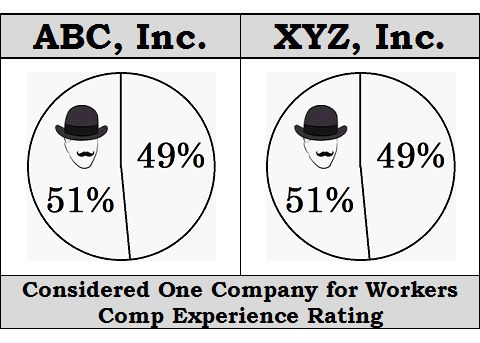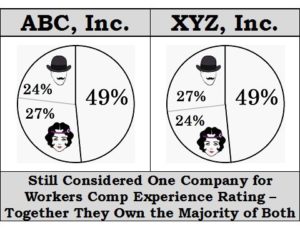Blog

Common Majority Ownership – Part 2 – A Little Clarification
Last month I wrote a blog about Common Majority Ownership (you can read it here) where I discussed how separate legal entities are tied together by the WCIRB when the same individual owns a majority of each of those entities.
It looks like this:

As you can see, since the guy with the derby owns more than 50% of each company, the WCIRB will treat both companies as one.
The net result is that both ABC & XYZ will share an Experience Modification (Xmod). Oh, and there’s another thing: No insurance company will insure one entity without the other(s). This is a sometimes unintended consequence that can wreak havoc on a business trying to operate on a budget. Why? Because not being able to insure one without the other makes it hard to find insurance, and “hard to find insurance” means hard to find quality insurance companies with competitive rates.
For example, let’s say that ABC is an electrical contracting company and XYZ is a horse breeding company. There are plenty of companies willing to insure an electrical contractor and there are a good handful of companies willing to insure a horse breeder. The problem is that most companies that insure electrical contractors will not insure a horse breeder, and most companies that insure horse breeders will not insure electrical contractors. (Insurance companies like to niche and are doing so with greater frequency). And since insurance companies will only insure all entities or none, your options as the owner of ABC and XYZ to find one company that will insure both is severely limited.
These two facts (same Xmod & hard to get insurance) may cause someone who owns multiple entities to redistribute shares so that he or she is not the majority owner in all of them.
This is what I want to clarify with this post. Before you sell your stock, know this: the WCIRB looks at the group of owners that make up the majority, not just individuals, in order to determine Common Majority Ownership.
For example, if the guy in the derby hat above owns 51% of both ABC and XYZ and his wife owns the remaining 49% of each, and he thinks that giving his wife an additional 2% in XYZ (making her the majority owner in XYZ) will relieve him of the common majority rule, he is mistaken. Why? Because the WCIRB looks at the collective: the same two people own a majority of both companies.
Here’s how it looks:

This rule applies to any number of people. If the same 3, 4, or 5, etc., people together make a majority of ownership of multiple entities, they will all be tied together.
Be in the know and avoid insurance surprises!
 ELI GILLESPIE
ELI GILLESPIE
I’m the commercial producer and owner at Gillespie Insurance Services.
SCHEDULE A CALL
SEND EMAIL





